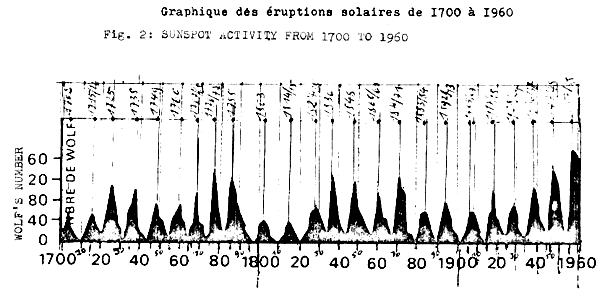CHAPTER SEVEN:
SUNSPOTS AND
POLITICAL AND ECONOMIC CRISES
[Note: This chapter, and all
others in this book, are excerpted from The End of Our Century by
Francois Masson, written in 1979-80. It was transcribed from French into English
by David Michael Steinberg in 1981 and a publisher was never found. It was
finally edited, updated and published on the Internet by David Wilcock in
2001.]
By observing sunspots, we
can make several deductions both physical and
paraphysical.
First of all, it is a cyclic phenomenon. Sunspot activity peaks every 11 years,
on the average, with the calmest periods at an interval of 5 years, 6
months.
During this solar activity, Aurourae Polaris (Aurora
Borealis) and magnetic storms are produced, with serious interference in radio
transmission, especially in the short-wave, high frequency bands.
Radar apparatus
is completely jammed by fogging during sunspots. Recent statistics also report an enormous increase in
myocardial
infarction during these periods.
But in addition to their
measurable physical effects, sunspots have a definite influence on human
behavior. The Russian scientist
Orloff demonstrated it in his theory connecting revolutions and sunspots, which
incidentally got him sent to prison and his works banned.

Although the average length of the sunspot cycle is 11 years, the individual periods vary a lot. As you can see on the graph (Fig. 2), the peaks do not conform exactly to the rule, and there are some that fall quite wide of the mark, e.g. the interval between the 1787/88 maximum and that of 1803/04 is practically 16 years.
But these are the points
that mark major events.
DATES OF MAXIMUM SOLAR ACTIVITY WITH CORRESPONDING REVOLTS, DEPRESSIONS, FAMINES, ETC.
|
1702: Protestant revolts in
France, General wars in Europe. Louis XIV in the West, Peter the Great in the
North.
1715: Scottish rebellion, depression and famine on the continent. Death of Louis XIV and big political changes.
1725: Fiscal revolt in Scotland.
Peter the Great dies. Russia enters upon 50 years of
strife.
1738: Workers’ revolts in
England. Wesley founds the first Methodist Society.
1749: Tax
revolt in France.
1760: Founding of Freemasonry. Condemnation of the Encyclopedists in France.
1767: New tariffs imposed on the British colonies in America. Revolts and boycott against these measures.
1766-77: Declaration of Independence; American War of Independence.
1787-88: True beginning of the French Revolution. Rioting in Paris, serious economic crisis and bankruptcy of the French State.
1814-15: Liberal rebellions in Spain
and various other European countries. Uprising in France in favor of Napoleon
upon his return from Elba. War; Waterloo.
1827: Serious depression in
Europe.
1836: Another European depression. Riots in France.
1848: Spontaneous popular revolution throughout Europe, including England and Ireland Enormous depression.
1860-61: Revolutions in Italy. South
Carolina secedes; the Civil war begins in the USA.
1870-71: Franco-Prussian War. The
Paris Commune. Apparition of Pontmain.
1882-84: Major
depression.
1892-93: European tariff war. Stock market crash in US.
1905-06: Russo-Japanese War: first defeat of the white man. Important revolts in Russia. Einstein.
1917-18: Revolution and total change in Russia. Rebellion in French and Italian armies, mutiny in the German fleet. Apparitions at Fatima. Sun Yat-Sen’s revolution in China.
1928-29: The
Great Depression begins. Peasant revolts in USSR against collectivization of
land. Famine, bloody purges, Revolts in Serbia,
Yugoslavia.
1936-37: Franco's rebellion in Spain civil war. General strikes in France. Start of the ideological wars, Fascism vs. Communism.
1947-48: Revolts in the Eastern satellite nations, revolts in Indo-China, Indonesia etc. Revolt of the Chinese Communists against Chiang Kai-Shek. Berlin wall crisis, etc.
1957-58: First uprising of French colonists in Algeria. Castro’s revolution in Cuba.
1968-69: World youth revolt. The Prague Spring, then the occupation of that land. Height of the Vietnam War, World monetary crisis. Gold crisis.
1979-80? New economic crisis? Numerous localized wars? First sign of the new religion in the USSR.
1990-91: Triumph of the new religion in Russia? After a revolt? An important fact is that the last three peaks of solar activity will surely coincide with the last three pivotal cyclic dates of our century; the final one, 1990-91 probably marking the end of the present USSR. In any case, these critical periods will have a strong effect on the type of human activity usually influenced by sunspots. |